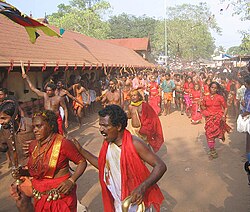This article needs additional citations for verification .(May 2025) |
| Kodungallur Sree Kurumba Bhagavati Temple | |
|---|---|
 Kodungallur Sree Kurumba Bhagavati Temple | |
| Religion | |
| Affiliation | Hinduism |
| District | Thrissur |
| Deity | Bhadrakali (Maha Kali, Durga or Aadi Parashakthi, Kannagi) |
| Location | |
| Location | Kodungallur |
| State | Kerala |
| Country | |
| Geographic coordinates | 10°13′37″N76°11′54″E / 10.226833°N 76.198425°E |
| Architecture | |
| Type | Architecture of Kerala |
| Completed | Before CE. Exact date not known |
| Specifications | |
| Temple(s) | One |
| Elevation | 32.53 m (107 ft) |
Sree Kurumba Bhagavati Temple (alternatively Kodungallur Kav) is a Hindu temple at Kodungallur, Thrissur District, Kerala state, India. It is dedicated to the goddess Bhadrakali, a form of Mahakali worshipped and significantly revered in Kerala. The goddess is known also by the names "Sri Kurumba" (The Mother of Kodungallur). This temple is the head of 64 Bhadrakali kavus in Malabar. This Mahakali temple is one of the oldest functioning temples in India. The goddess of the temple represents the goddess in her fierce ('ugra') form, facing North, featuring eight hands with various attributes. One is holding the head of the demon king Daruka, another a sickle-shaped sword, next an anklet, another a bell, among others. [1]
Contents
The temple is often accredited as the original form of Goddess Kali. [ citation needed ] During the reign of Later Cheras, Mahodayapuram (Kodungallur) was the capital of the Chera empire and one of the most important parts of the region. The temple is located in Thrissur district, central Kerala. The Temple was built in a remote past and its worship incorporates ancient Shaktyeism customs which are rarely observed in contemporary Kerala temples. [ citation needed ]

The priests of Kodungallur temple convey the story that this temple was, in the olden days, a Shiva shrine and it was Parasurama who installed the murti of Bhadrakali close to one of Shiva. The moolasthana (the original or primary seat or location of a deity) of the devi is located in Pulapadam at Keezhkav. The head priest is known as Vallon belonging to the hindu pulayar community. The pujas are conducted, it is said, under direct instructions from the goddess herself. Five 'Sri Chakras', said to have been installed by Adi Shankaracharya, are believed to be the main source of the powers of this deity. The priests are Adikals (who have a right to perform 'Pushpanjalis' to the Goddess). It is said that the temple was constructed by Kadalpirakottiya Cheran Chenkuttuvan. The first Shakteya Pooja in kodungallur temple was performed by a Thiyyar from Malabar. Even present day, the Thiyya thandans (An administrative position) of 64 tharas meet at Nilapaduthara at Kodungaloor in the presence of kodungallur raja. The kodungaloor meena bharani is conducted under these Thiyya thandans[ citation needed ]
According to legend, it is in this temple that Kannaki Amman, the heroine of Ilango Adigal's Tamil story Silappathikaram attained salvation. [2] [ failed verification ] She came to Kodungallur, prayed to Bhadrakali of Kodungallur and became absorbed in the murti.
It is believed that the temple was constructed by Kadalpirakottiya Cheran Chenkuttuvan the greatest Chera emperor of Sangam Era.
In ancient times, animal sacrifices were offered at the temple, mostly in the forms of birds and goats, by devotees seeking protection and the fulfillment of their prayers. At the intervention of many social reformers, the government of Cochin banned animal sacrifice in any form at this place. At present, only red-dyed dhotis are offered to the deity. Many devotees offer rich presents and gold ornaments. [3] [4] [ disputed – discuss ]





